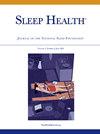Neighborhood social vulnerability as a mediator of racial disparities in insomnia severity
IF 3.4
2区 医学
Q2 CLINICAL NEUROLOGY
引用次数: 0
Abstract
Study objectives
Recent data has indicated that Black Americans experience more severe insomnia compared to their White counterparts. Although previous studies have identified psychosocial mechanisms driving this disparity, little is known about the structural determinants of insomnia disparities. This study tested neighborhood social vulnerability as a mechanism driving Black-White disparities in insomnia severity in the United States.
Methods
Participants with a previous diagnosis of insomnia (N = 196) reported their race and insomnia severity (Insomnia Severity Index). As a measure of the neighborhood environment Social Vulnerability Index was calculated by geocoding home address at the time of participation to the respective census tract from the 2020 US Census. A mediation analysis tested the indirect effect of the Social Vulnerability Index between race and insomnia severity.
Results
Black participants reported worse insomnia severity compared to White participants. Black participants also had 3.3 times the odds of living in neighborhoods with higher social vulnerability compared to White participants, with a group median difference of 0.26 percentile points (scale 0 to 1). As hypothesized, results revealed a significant indirect effect of the Social Vulnerability Index, which accounted for 31.1% of the variance between race and insomnia severity.
Conclusion
Living in a socially vulnerable neighborhood environment may be a mechanism driving racial disparities in insomnia severity. Interventions that consider structural determinants of health, including community-based and policy-level interventions could have an enhanced impact on addressing insomnia and its public health consequences.
邻里社会脆弱性是失眠严重程度种族差异的中介因素。
研究目的:最近的数据表明,美国黑人与白人相比失眠更严重。尽管之前的研究已经发现了导致这种差异的社会心理机制,但对失眠差异的结构性决定因素却知之甚少。本研究测试了邻里社会脆弱性作为美国黑人与白人失眠严重程度差异的驱动机制:曾被诊断为失眠的参与者(196 人)报告了他们的种族和失眠严重程度(失眠严重程度指数)。作为邻里环境的衡量标准,社会脆弱性指数是通过将参加调查时的家庭住址与2020年美国人口普查中的相应普查区进行地理编码计算得出的。一项中介分析检验了社会弱势指数在种族和失眠严重程度之间的间接影响:结果:与白人参与者相比,黑人参与者的失眠严重程度更严重。与白人参与者相比,黑人参与者居住在社会脆弱性较高社区的几率是白人参与者的 3.3 倍,群体中位数差异为 0.26 个百分点(0 到 1)。正如假设的那样,结果显示社会脆弱性指数具有显著的间接影响,占种族与失眠严重程度之间差异的 31.1%:结论:生活在社会弱势社区环境中可能是导致失眠严重程度种族差异的一个机制。考虑到健康结构性决定因素的干预措施,包括基于社区和政策层面的干预措施,可能会对解决失眠及其对公共健康的影响产生更大的影响。
本文章由计算机程序翻译,如有差异,请以英文原文为准。
求助全文
约1分钟内获得全文
求助全文
来源期刊

Sleep Health
CLINICAL NEUROLOGY-
CiteScore
6.30
自引率
9.80%
发文量
114
审稿时长
54 days
期刊介绍:
Sleep Health Journal of the National Sleep Foundation is a multidisciplinary journal that explores sleep''s role in population health and elucidates the social science perspective on sleep and health. Aligned with the National Sleep Foundation''s global authoritative, evidence-based voice for sleep health, the journal serves as the foremost publication for manuscripts that advance the sleep health of all members of society.The scope of the journal extends across diverse sleep-related fields, including anthropology, education, health services research, human development, international health, law, mental health, nursing, nutrition, psychology, public health, public policy, fatigue management, transportation, social work, and sociology. The journal welcomes original research articles, review articles, brief reports, special articles, letters to the editor, editorials, and commentaries.
 求助内容:
求助内容: 应助结果提醒方式:
应助结果提醒方式:


